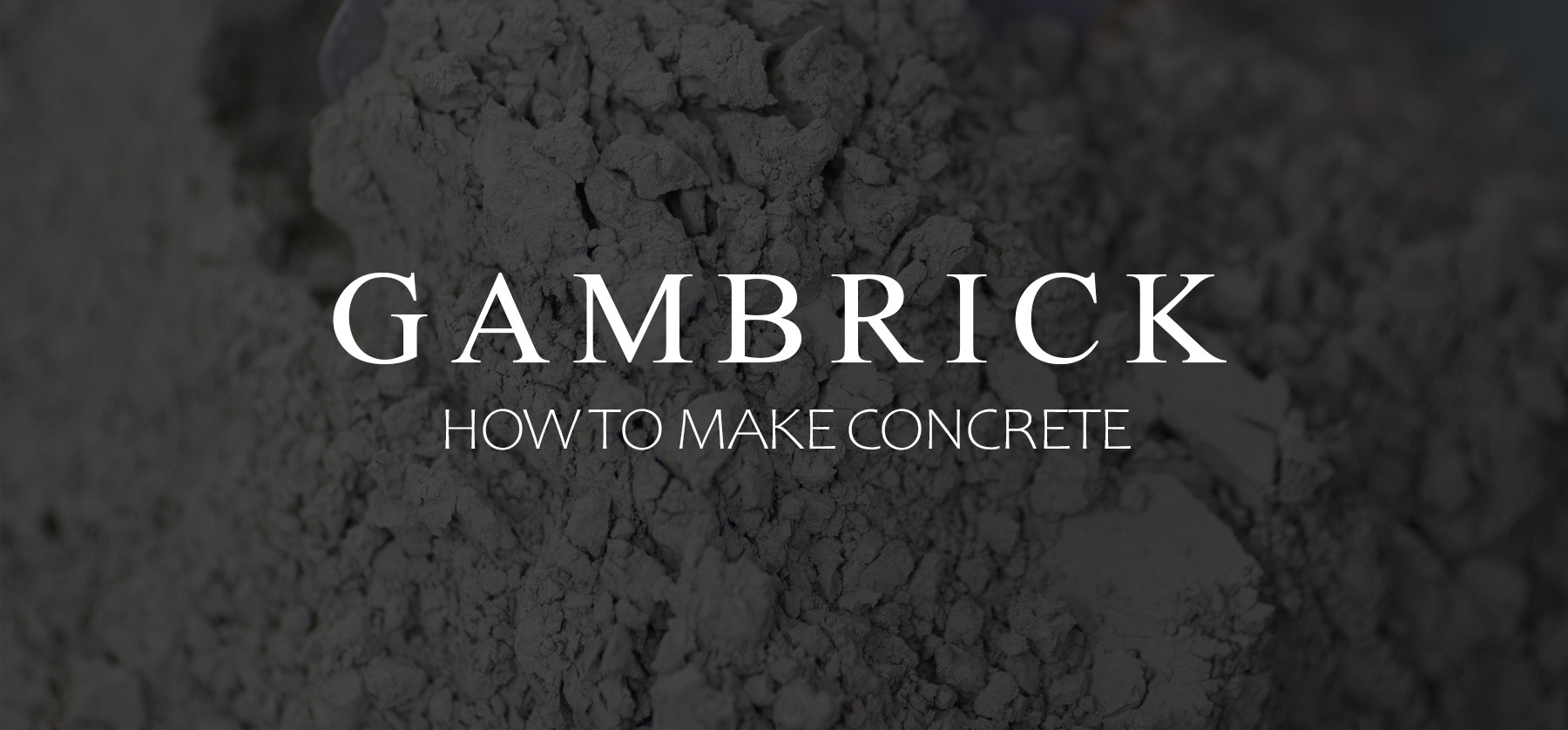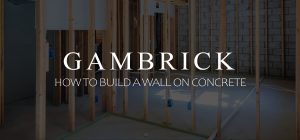
How To Make Concrete
To make concrete, you must first make dry concrete powder, which is cement, sand, aggregate (course gravel). The dry mix is then mixed with water to form concrete. The basic mixture is one part cement, two parts sand, and three parts aggregate. Mix all the dry ingredients together really well before adding water. A good dry mix is very important if you want a finished concrete with consistent strength and color. Areas of unmixed ingredients will lead to weak spot in your concrete and discoloration.
Think of mixing concrete the same as with a cake. If you don’t mix all the ingredients together thoroughly before cooking, the cake won’t turn out right. Finally mix in water until the concrete is like thick oatmeal but not too wet. I’ve been a mason for over 25 years and cal tell you that concrete’s consistency is extremely important. If it’s too wet or too dry, the concrete will be weak and prone to cracking.
A typical concrete mix is 1 part cement, 2 parts sand, and 3 parts aggregate in addition to water and air. This creates a good all around concrete with a strength of around 3500 psi. This is just the right strength for more construction projects like walkways, patios, driveways, sidewalks and even some foundations. It’s also workable enough to be used for most repair jobs.
Making your own concrete can be inconsistent at times which is why most homeowners buy premixed bags. Make sure to carefully measure your ingredients and thoroughly mix your dry bath before adding water. Consistency and accuracy are key to creating good concrete.
Here are some tips, information and tricks to help you produce the best concrete mix.
The Ingredients That Make Concrete
Concrete is made by mixing 3 main ingredients with water, aggregate, sand and cement.
Aggregate
Good quality aggregate should be clean, strong, and free of any harmful chemicals. Buy a gravel that has a variety of stone sizes ranging from around the size of a quarter to a dime. Aggregates comprise 60 to 75 percent of the total finished volume. The type and size of aggregate used depends on the thickness and purpose of the final product
Aggregate makes up 3 parts of your mix and greatly helps the durability and strength of the concrete.
Choosing aggregate that’s not weathered or porous is an important part of mixing good concrete. More porous gravel can trap air within your concrete which weakens it. Weathered gravel decays more quickly which always weakens the concrete.
Consistent aggregate is also important. You want a good mix of stone sizes without any that are too large or too small. This helps keep an even amount of stone throughout the concrete and a consistent strength.
The more aggregate you add the thicker and stronger the concrete will be. One of the ways to boost your concrete psi level from 3500 all the way up to 5000 is adding a bit more stone. This makes the concrete stiffer and a bit harder to work with but it’s better for footings and foundations. You can use a thicker concrete for slabs 4″ and up but it’s not meant for thin applications.
Using a finer aggregate produces a smoother finish but a weaker concrete. Although some projects may require a low psi concrete.
Residential construction generally calls for small coarse aggregate, though aggregates up to six inches in diameter have been used in large dams. Some variation in particle sizes tends to be best. In addition, aggregates should be clean and free from any matter that might affect the quality of the concrete.
Cement
Cement is the binding agent in concrete. It’s made of a mixture of limestone and clay materials that have been heated to high temperatures so that they sets up and hardens independently.
In construction, non-hydraulic and hydraulic cement is most common. Non-hydraulic cement can’t harden while it’s in contact with water, while hydraulic cement can. The concrete you’ll most likely be using for all your project is hydraulic. That’s what’s inside a Quikrete premixed bag and just about every concrete truck.
Portland Cement (hydraulic) is the most common but there are other options.
- Mortar Cement
- Masonry Cement
- Rapid Hardening Cement
- Quick Setting Cement
- Low Heat Cement
- Sulfate Resistant Cement
99.9% of the time we use Portland cement. If your building a sidewalk, patio, walkway, steps or even a foundation then you’ll most likely make your concrete with Portland. Other forms of cement are used for specialized mixes.
You can buy Portland cement at your local hardware store, and can even get it premixed with aggregate. Although we like to buy our ingredients separate so we can mix our own in the ratios we want. When you buy separate ingredients you get more control over the finished product.
Sand
You can buy sand bags at just about any hardware store or get a small truck load dropped at the job. Sand makes up about 2 parts of the mix so calculate your ingredients carefully.
Home Depot sells 60 pound bags of sand for around $5 bucks. It’s cheaper to buy it by the truck load if you need a lot but for small jobs buying by the bag is generally better.
Sand is very fine and can hold moisture. Keep this in mind when you measure the water you’ll need. This is one of the reasons why we add water slowly when mixing. Too much water is bad because it weakens the concrete so it’s best to add water until the consistency is right rather than adding a predetermined amount like you do with dry ingredients.
Water
Fresh, clean water is a very important. It helps bind and determine the strength and color of your concrete. Almost any natural water that is drinkable and has no pronounced taste or odor may be used as mixing water for concrete. Excessive impurities can not only affect setting time and concrete strength, but can also cause efflorescence, staining, corrosion of reinforcements like rebar, volume instability, and reduced durability.
Concrete mixture specifications usually set limits on chlorides, sulfates, alkalis, and solids in mixing water unless tests can be performed to determine the effect the impurity has on the final concrete.
Overall, regular tap water is the best option. If necessary, tests can be done on your water to ensure it is safe and clean. But in general, if water is safe enough to drink then it’s fine for making concrete.
Don’t use salt water. Use only clean, fresh water.
Air
Air is another important component. Small, well spaced air bubbles is a good thing and helps the concrete cure. Air bubbles provide spaces for freezing and thawing water to go. This is called entreated air. It also helps the workability a bit.
If you want a bit more air then buy an air entrained mix or include additives that create air bubbles.
Mixing And Ratios
Mixing concrete may sound easy easy, but it takes careful measuring and thorough mixing to get it right. First, measure the ingredients out. Be careful because if you want consistency from batch to batch then the ingredients have to be exactly the same. Mix together the cement, sand and aggregate really well until you’ve got a finished dry mix.
After you’ve made your dry batch, start adding water. Mix in the water until all your concrete is wet but there isn’t any freestanding water. Too little water leaves unmixed powder and too much makes things soupy. When water is done right the consistency should be like a paste. You should be able to hold wet concrete in your hand without it slipping through your fingers. If it’s too soupy to hold then add dry in until it gets pasty.
Sprinkle your water in gradually until you get the hang of it. As mentioned previously, the ratio is one part cement, two parts sand, and three parts aggregate with enough water to create a paste. Generally this takes one part water but that may vary depending on the moisture content of your sand. This is why we don’t recommend an exact water level like with the dry components. Since moisture can be held in the dry ingredients water levels will vary a bit.
Too much water will weaken concrete. It’s tempting to add more because more water makes concrete easier to work with but it comes at a cost. To keep the strength high just add what you need.
Too much water can also effect the color. To avoid discoloration just add what you need.
Proportioning
The key to achieving a strong, durable concrete is in the careful proportioning and mixing of the ingredients. A mixture that does not have enough cement & sand to fill all the voids between the aggregate will be difficult to work with and can produce rough surfaces and porous concrete. A mixture with an excess of cement & sand will be easy to spread and will produce a smooth surface, however, the resulting concrete will be weaker and prone to cracks.
Portland cement’s chemistry takes effect when introduced to water. Cement and water form a paste that coats each particle of stone and sand which are the aggregates. Through a chemical reaction called hydration, the cement paste and other ingredients harden and gains strength.
The quality of the paste determines the strength of the concrete. The strength of the paste, in turn, depends on the ratio of water to cement. High strength concrete is produced by lowering the water cement ratio as much as possible without sacrificing the workability of the concrete. This is why we recommend mixing in water slowly until the concrete is workable. Don’t include a drop more than you need.
A proper mix of dry and water will give you the workability you need to do the job and the required durability and strength.
Getting the Correct Consistency
Concrete that’s too runny will reduce the compression strength which causes it to deteriorate much more quickly over time. Too little water makes the job harder but it doesn’t reduce strength. You need just enough water to form a paste and bind the components together but not so much that the mix feels like soup.
A great way to check your consistency is by picking some up with your hand. If you can hold and form the concrete in your hand like putty then it’s OK. If it runs through your fingers then you’ve got too much water.
You don’t want your mix to be too dry, or too soupy. If you end up having too much water then add some more dry mix to balance things out. On the other hand, if your mix is too dry to work with then add just enough water to make it workable. As long as the mix is soft enough to work with then you’ve got enough water.
Directions
Mix all of your dry ingredients in a wheelbarrow or mixer. Approximately 1 part cement, 2 parts sand, and 3 parts aggregate. Mix enough water to make a smooth consistency. There should not be any lumps and the mix shouldn’t be soupy.
**The less water you can use the better. If the mix gets too wet, you will compromise the strength of the concrete. However if it’s too dry you may not be able to work with it.**
Additives
You can add more ingredients into your mix for additional effects.
If you’d like any of these additives in your mix there are premixed bags with them already included. Premixed makes things easier if your unfamiliar with using additives.
Here’s a few common additives that may be needed depending upon your project:
- Air entraining agents: Air bubbles may be needed if your building in a colder climate. Air entraining agents are what creates the bubbles. Bubbles improve the durability of concrete that’s exposed to moisture during cycles of freezing and thawing. If you live in a climate where it doesn’t freeze, you probably won’t need this additive. Entrained air will also improve the concrete’s resistance to surface flaking and scaling caused by chemical ice removers such as salt. All mixes have some amount of air bubbles naturally mixed in.
- Fiber Mesh: This additive helps strengthen the mix and prevent against cracking. It’s a plastic fiber ingredient that you throw in while mixing the water into your dry mix. Use one bag of fiber mesh per cubic yard of concrete and mix well.
- Calcium Chloride: This is an additive that makes your concrete get hard faster. Generally we only use it in cold and wet climates. In hot areas you won’t have a problem with your project getting hard, but in a cold damp area it could take a long time for things to set up and cure. Adding a little calcium chloride can help. Make sure if you use it that you mix it in really well. Calcium can effect the color and create blotches if it’s not thoroughly mixed.
If your project is large then it may be better to get a delivery. Although this is the most expensive option it’s also the least labor intensive.
The Curing process
Soon after the aggregates, water, and cement are combined, the mixture starts to harden. Portland cements are hydraulic which means they set and harden through a chemical reaction with water call hydration. During this reaction, a node forms on the surface of each cement particle. The node grows and expands until it links up with nodes from other cement particles or adheres to adjacent aggregates. This is commonly referred to as curing.
Once the concrete is thoroughly mixed and is the right consistency it should be placed in forms before the mixture becomes too stiff.
During placement, the concrete is jigged or wiggled to compact it within the forms and to eliminate potential flaws, such air pockets.
Curing begins after the exposed surfaces of the concrete has hardened. Curing continues in some cases for over a day and the concrete continues to harden. Even though that new sidewalk may be safe to walk on after 7-10 hours it’s probably not fully cured for at least a day.
Curing Takes Time
The longer concrete is kept moist, the stronger and more durable it will become.
The rate of hardening depends upon the composition and fineness of the cement, the mix proportions, and the moisture and temperature conditions. Concrete continues to get stronger as it gets older. Most of the hydration and strength gain take place within the first month of concrete’s life cycle, but hydration continues at a slower rate for many years.
Summary: How To Make Concrete
To make concrete, mix cement, sand, aggregate (course gravel), and water together. The basic mixture is one part cement, two parts sand, and three parts aggregate. Mix all the dry ingredients together really well before you add any water. A good dry mix is very important if you want a finished concrete with consistent strength and color. Areas of unmixed ingredients will lead to weak spot in your concrete and discoloration. Think of mixing concrete the same as with a cake. If you don’t mix all the ingredients together thoroughly before cooking, the cake won’t turn out right. Finally mix in water until the concrete is like thick oatmeal but not too wet. Wet concrete should still be solid and not thin like water. If you pick up wet concrete and it runs through your fingers then it’s too wet.
A typical concrete mix is one part cement, 2 parts sand, and 3 parts aggregate in addition to water and air. This creates a good all around concrete with a strength of around 3500 psi. This is just the right strength for more construction projects like walkways, patios, driveways, sidewalks and even some foundations. It’s also workable enough to be used for most repair jobs.
Making your own concrete can be inconsistent at times which is why most homeowners buy premixed bags. Make sure to carefully measure your ingredients and thoroughly mix your dry bath before adding water. Consistency and accuracy are key to creating good concrete.
If you have any questions or comments e-mail us any time. We’d love to hear from you.

John Mazzuca | About | More Posts |
Custom Home Builder
John Mazzuca is a custom home designer and builder at Gambrick with over 25 years experience in the construction industry. John has designed, built and/or remodeled hundreds of homes, small buildings, and commercial projects. He writes about business, real estate, home building, and household electronics. His work has been featured in Fox Business, Better Homes & Garden, House Beautiful, and more.




















